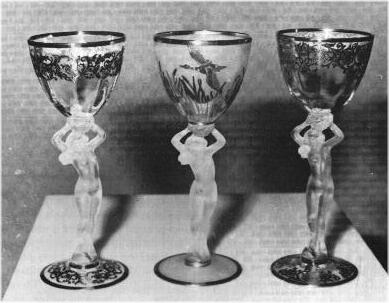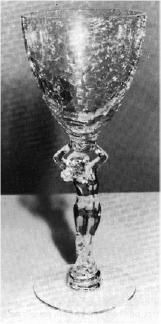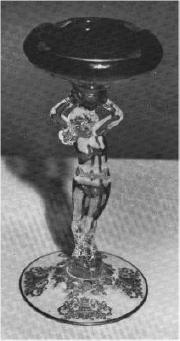National Depression Glass Association
Preserving America's Glass Manufacturing Heritage
Cambridge Decorated Nudes
by David & Joy McFadden, Frank & Vicki Wollenhaupt
Glass Review - February 1978
If you prefer the unusual, Cambridge can offer you several decorations and special treatments on the nude stem.
 Probably the most easily found by the collector, would be the two
sizes of the Crown Tuscan nude stem comports with a "Charleton"
decoration. These decorations were usually hand-painted floral designs
with gold accents. Charleton is the name of the decorating company
which applied this decoration to Cambridge Crown Tuscan glassware.
Probably the most easily found by the collector, would be the two
sizes of the Crown Tuscan nude stem comports with a "Charleton"
decoration. These decorations were usually hand-painted floral designs
with gold accents. Charleton is the name of the decorating company
which applied this decoration to Cambridge Crown Tuscan glassware.
Another type of decoration was applied to Cambridge glass by the
Rockwell Silver Company. This is sterling silver overlay applied to the
glass. (See photo at right). Shown in the photo are the three known
types of Silver decoration. It should be noted that the body is usually
satin finished, however the bowl and foot may or may not be satin
finished. The majority of these silver decorated nudes have been found
with the Rockwell acid stamp signature, and this is found on the
underside of the foot. The Rockwell signature is a shield with the name
Rockwell on the inside of the shield. The word "Sterling" frequently
 appears on some part of the silver decoration. Although the photo shows
only the claret, silver decoration has also been found on the table
goblet and the saucer champagne. This silver decoration should be
considered among the more rare decorations and should command a high
price.
appears on some part of the silver decoration. Although the photo shows
only the claret, silver decoration has also been found on the table
goblet and the saucer champagne. This silver decoration should be
considered among the more rare decorations and should command a high
price.
One of the more sought after nude stem treatments that was done by
the Cambridge Glass Company is commonly called "crackle glass." (Photo
at left) As you will note from the photo, only the bowl of the goblet
has the crackle effect According to an original 1956 Cambridge Glass
Price List, crackle bowls could be found on table goblets, sherbets
 (saucer champagnes), and the 3011/9 cocktail. They were offered in the
following colors: Smoke, Pink, Mandarin Gold, Moonlight Blue and
Pistachio. It is accepted knowledge, but unverifiable among Cambridge
collectors, that Cambridge Glass Company made crackle glass on nudes,
probably in the 1940s. The crackle bowl was Carmen in color. These have
been found in the following sizes: table goblet, saucer champagne and
claret. The crackle effect on the nude stem is scarce, probably due to a
high amount of breakage during production and the price should reflect
this.
(saucer champagnes), and the 3011/9 cocktail. They were offered in the
following colors: Smoke, Pink, Mandarin Gold, Moonlight Blue and
Pistachio. It is accepted knowledge, but unverifiable among Cambridge
collectors, that Cambridge Glass Company made crackle glass on nudes,
probably in the 1940s. The crackle bowl was Carmen in color. These have
been found in the following sizes: table goblet, saucer champagne and
claret. The crackle effect on the nude stem is scarce, probably due to a
high amount of breakage during production and the price should reflect
this.
Etchings were mentioned in last month's article, but Cambridge also encrusted their etchings with gold. To date, nude stem items with etchings encrusted with gold have not been seen in drinking vessels, but it is assumed that they were produced. The nude stem ashtray (photo at right) has a Carmen ashtray with a crystal nude stem and foot. The Portia etching, which appears on the foot, is encrusted with gold. There is a line of gold around the rim of the foot and the ashtray is also trimmed with a gold line and gold in the cigarette rests.
The Cambridge Glass Company did another very simple treatment to the nude stem with gold or platinum. A single line of the gold or platinum has been seen applied around the rim of the bowl and/or on the rim of the foot. This type of decoration has been seen on dark green table goblets and saucer champagnes.